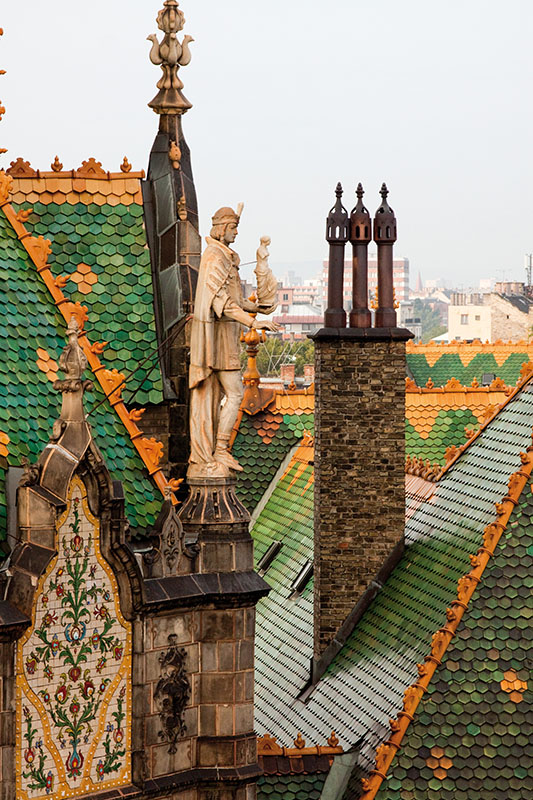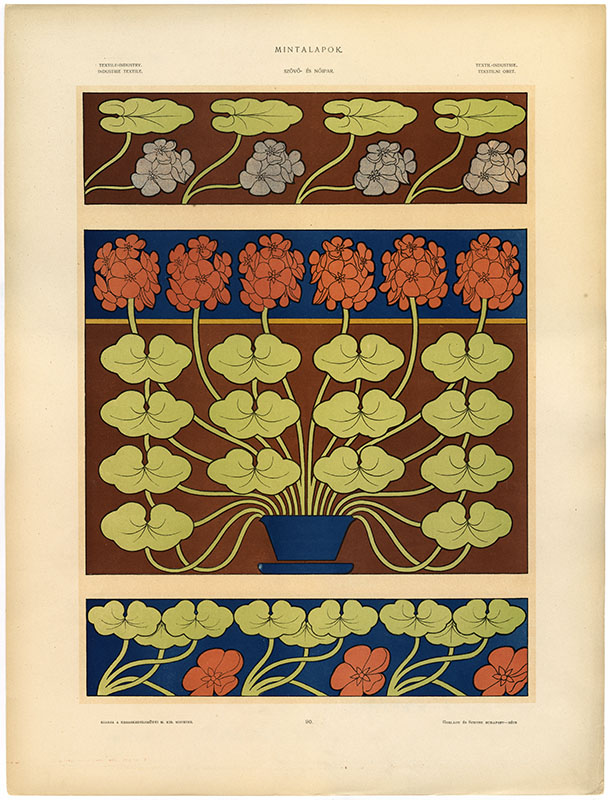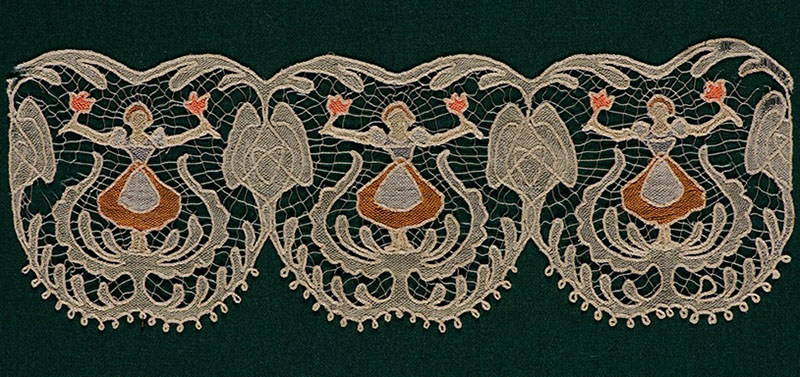National Identity and Vibrant Expression: Hungary’s Magyar Szecesszió Art Nouveau Movement
by Laura Erdős Fernandez
During the late 19th to 20th centuries, Hungary showcased diverse designs and styles in decorative arts, as demonstrated by beautiful examples of architecture, ceramics, porcelain, and textiles. Hungary’s Golden Era was intellectually and culturally vibrant, leaving a bold mark on national identity. It was also a time when the Austro-Hungarian Empire granted Hungary a level of internal independence, which sparked a movement toward Hungarian identity through assimilation and acculturation known as Magyarization.1
In the interest of Hungarian (Magyar) plurality, Hungary transitioned towards a modern, metropolitan, middle-class society, sharing national dishes and social mobility across class lines. In response to these motives, the Magyar Szecesszió (Secession) art movement emerged, aiming to express and display Hungary’s own national identity, and an unrestricted, expressive Art Nouveau style was adopted, as seen earlier in Europe.2 For Hungary, the term Szecesszió held significant meaning, suggesting escapism and the urge to disassociate from traditional European styles toward more ideological modern artistic forms. This shift created a unique style, instilling hope, and positivity for Hungarians while it paid homage to the history of the Magyars, drawing inspiration from Hungarian cultural folk art motifs and distinctive design elements from its Eastern roots.
Beautiful Magyar Szecesszió architecture and decorations are ubiquitous in Budapest and have left a powerful imprint on the city. Ödön Lechner (1845–1914), a Hungarian architect and major figure in Magyar Szecesszió art, created a progressive and distinctive architectural style by blending traditional Hungarian folk-art motifs with decorative elements from Eastern cultures. His use of Hungarian folklore-inspired flowers, mythological shapes, and textile patterns from the East—including influences from Turkey, Persia, and India—made his designs highly innovative and distinctive. Lechner closely collaborated with Vilmos Zsolnay (1820–1900), the founder of Zsolnay Porcelain Manufactory in Pécs. The Zsolnay Factory (1855–present) contributed greatly to the Magyar Szecesszió style by producing non-porous ceramic tiles used as decorative building elements as well as decorative iridescent porcelain.3 Lechner and Zsolnay studied Eastern ceramic art, Indian patterns, England’s Arts and Crafts movement, including John Ruskin and William Morris, and the concept of Gesamtkunstwerk, the “Total-Work-of-Art”.4 Lechner incorporated Zsolnay tiles with patterns that recognized the Eastern origins of Hungarian culture (figure 1).
Prominent examples of Lechner’s Magyar Szecesszió style include The Museum of Applied Arts (completed in 1896), the Hungarian Geological Institute Building (completed in 1899), and the Hungarian Royal Postal Savings Bank (completed in 1901). These buildings are unique because they incorporate motifs from Indian, Persian, Moorish, and Hungarian folk art, richly decorated with terracotta tiles created by various artists at the renowned Zsolnay factory. The Museum of Applied Arts (figures 2 and 3) is a striking example of Magyar Szecesszió art and the connection between ancient Magyar cultures and Eastern cultures. Zsolnay ceramic tiles (both glazed earthenware roof tiles and pyrogranite ornamental tiles) play a significant role here, and the spires, onion-shaped carved finials, spindled chimneys, and bell- shaped domes showcase Hungary’s eastern roots.
Figure 2. Roofs of the Museum of Applied Arts, Budapest, with Zsolnay ceramic tiles by Odon Lechner and Gyula Partos. Photo courtesy of Museum of Applied Arts Budapest. Accession number VLT 38.3.2. Photo courtesy of Virág Zsabó © Museum of Applied Arts, Budapest. Description ©Museum of Applied Arts, Budapest.
In addition to being inspired during his travels, Lechner found inspiration for architectural tile and interior and exterior façade decorative art from extensively illustrated pattern books and embroidery designs (figure 4). József Huszka’s Magyarische Ornamentik (1898) and Hungarian Decorative Style of 1885 both provided a trove of Hungarian folk motifs and floral compositions as inspiration for many of his works.5 The Art of the Hungarian People by Aladár Körösfói Kriesch and references to Eastern motifs from James Fergusson’s History of Indian and Eastern Architecture (1876) and Eugène-Victor Collinot and Adalbert de Beaumont’s Ornements de la Perse Recueil De Dessins pour L’Art Et L’Industrie (1883) were utilized as sources for reference and inspiration.6
In addition to Zsolnay’s unique material of pyrogranite for architectural use, eosin ceramics are one of the most well-known examples of Magyar Szecesszió decorative art. Zsolnay’s mastery of eosin-luster metallic glaze porcelain became a symbol of national pride and cultural heritage in Hungary. The eosin process, introduced in 1893, produces iridescent glazes and unique colored luster glazes for decorative sculptures, vases, and building reliefs. Several artists, including Sándor Apáti Abt, Lajos Mack, Géza Nikelszky, and József Rippl-Rónai, were known for nature designs that utilized eosin-based iridescence. Figure 5 shows a stunning eosin-based pitcher designed by Hungarian artist Lajos Mack (1876–1973), most well-known for his figural ceramic vases and pitchers. This pitcher features relief decorations inspired by nature with an iridescent metallic green-gold luster. In the Magyar Szecesszió style, the design emphasized textures of sinuous, curvilinear lines of stylized organic plant forms with erotic undertones.
Figure 5. Designed by Lajos Mack, Manufactured by Zsolnay Factory, 𝘓𝘦𝘢𝘧 𝘗𝘪𝘵𝘤𝘩𝘦𝘳, c. 1901, Pècs, Hungary. Eosin-glazed fine white earthenware. Cooper Hewitt, Smithsonian Design Museum. Museum purchase from Charles E. Sampson Memorial Fund, 2007-3-1. Photo courtesy of photographer Matt Flynn ©Smithsonian Institution.
Peasant culture exerted a powerful influence on Magyar Szecesszió design. Halas lace, from the town of Kiskunhalas, first appeared in 1902 as trimming for fans, cuffs, collars, decorative kerchiefs, womens’ aprons, and tie frills for men and has since become an important part of Hungarian folk art.7 Árpád Dékáni (1861–1931), the most famous designer of Halas lace, collaborated with lace maker Maria Markovits (1875–1954) to produce unique designs (figures 6 and 7). Dekani captured the essence of Hungarian character by encompassing natural elements found in Hungary, such as tulips, roses, lilies, cherries, pomegranates, paprika peppers, squills, palmettes, sickle-shaped leaves, deer, doves, and peacocks. The peculiarity of Halas lace lies in the use of colored flax or silk or metallic threads, and heavily outlined motifs, which was rare in traditional European lacemaking except for Spanish Chantilly lace. The Kiskunhalas Lace Workshop was one of the first built at the turn of the century and still functions today.
Figure 6. Designed by Árpád Dékáni, produced by Mária Markovitz at Kiskunhalas (Halas) Lace Workshop, Halas Lace Trimming, Kiskunhalas, Hungary. Accession number 10589. Photos courtesy of Gellért Áment © The Museum of Applied Arts, Budapest.
Magyar Szecesszió played a notable role in both public and residential spaces during the late 1800s to early 1900s. Today, the unusual materials and textures of Magyar Szecesszió can be seen in many parts of Budapest in municipal buildings, spas, zoos, hotels, churches, synagogues, museums, ceramics, stained glass, furnishings, and textiles. Hungary created its own language of form and independent approach to decorative arts and material science while blending an eclectic mix of traditional folk-art motifs with ornamental elements from its Eastern roots.
- Judit Szabadi, Art Nouveau in Hungary, (Budapest: Cornina, 1989), 116.
- David A. Hill, “Cycles in the Life of Budapest Secession Buildings,” Hungarian Review Vol 2, Number 3, (April 2011): 2.
- Hans Van Lemmen and Verbrugge, Bart, Art Nouveau Tiles, (New York: Rizzoli, 1999), 123.
- Brandow-Faller, Megan, “Art Nouveau and Hungarian Cultural Nationalism”. Comparative Hungarian Cultural Studies. (2011): 7.
- Katalin Keserü, “Vernacularism and Its Special Characteristics in Hungarian Art,” in Art and the National Dream, A Search for Vernacular Expression in Turn of the Century Design. (Dublin: Irish Academic Press,1992), 134.
- Sisa, József, “Lechner, a Creative Genius.” Publication of the Museum of Applied Arts, Institute of Art History, Research Center for the Humanities, Hungarian Academy of the Sciences. Aduprint Nyomba Kft, Budapest, 2014, 19-20.
- Emoke, Lázló, “Lace from the Secession (Hungarian Art Nouveau): Sewn Colored Lace Articles” in Conserving Textiles, ICCROM Conservation Studies, Vol.7. Chapter 13 (Rome, Italy:ICCROM, 2009), 107.
Laura Erdős Fernandez is a freelance researcher and writer and holds a master’s degree in History of Design and Curatorial Studies from Parsons School of Design, in partnership with Cooper Hewitt, Smithsonian Design Museum.
About The Decorative Arts Trust Bulletin
Formerly known as the "blog,” the Bulletin features new research and scholarship, travelogues, book reviews, and museum and gallery exhibitions. The Bulletin complements The Magazine of the Decorative Arts Trust, our biannual members publication.
Click Images to Enlarge
Did you know that clicking on the images in Bulletin posts will allow you to get a closer look? Simply click on an image, and a larger version will open in a pop-up window.














